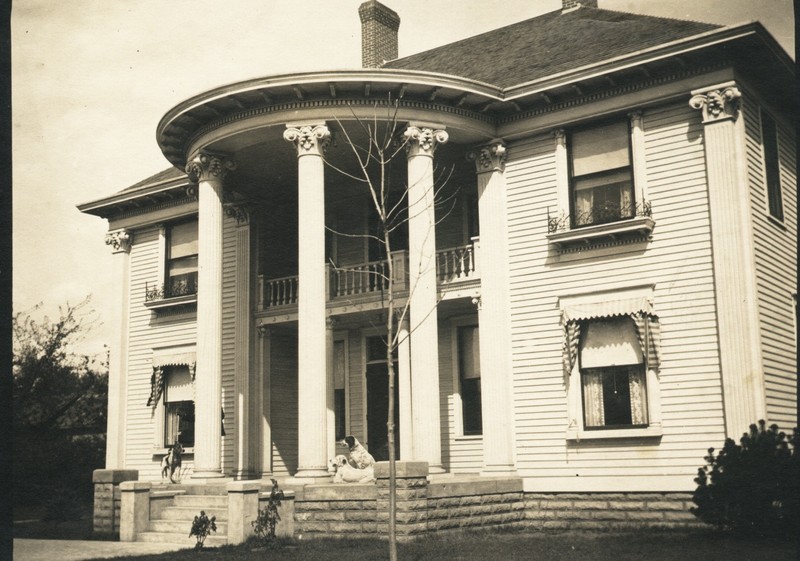Colonial Hall and Masonic Lodge No. 30
Introduction
Author-Uploaded Audio
Listen to a narration of this entry's description by Richard Oxley.
Text-to-speech Audio
Images



Backstory and Context
Text-to-speech Audio
Dominating the structure visually from the front is the home’s semi-circle portico, which is flanked by symmetrical windows on both floors. Four Corinthian-style columns originally supported the portico, but in 2019, only two remain. Fluted pilaster strips decorate these columns, which are capped by Corinthian capitals.
The eaves of the hipped roof are dentillated, giving the appearance of a classical cornice. Though two chimneys continue the symmetry, when the house was built, only the north chimney functioned; the southern chimney merely served a decorative function and balanced the design. The circular theme of the portico is mirrored by a round window on the south side of the second floor, a wooden spiral staircase, and rounded interior corners within the dining room.
The home served a dual purpose for its owners: the married physicians Flora and Alanson Aldrich. The couple used it as a residence as well as a site for their separate offices, which occupied the north side on the main floor. The patients used a separate entrance.
Alanson Aldrich specialized in otolaryngology (the medical study of the ear, nose, and throat) and earned an international reputation as an innovator in his field. Although he maintained an office in Colonial Hall, his main practice was in Minneapolis. He was a member of the Hennepin County Medical Society, the State Medical Society, and the American Medical Association. He was also an active member of the Masons. Flora Aldrich specialized in women’s and children’s health and maintained her practice in Anoka while also serving as a charter member of Anoka’s Philolectian Society.
Following the Aldrichs' deaths, the local Masonic lodge (no. 30) stepped forward and purchased the house. In 1922, it built a lodge hall next to the Aldrich home and added a passageway connecting all levels of the two structures. Emulating its neighbor, the lodge also evokes the Greek Revival style with its symmetry, a round window at its peak, and an elegantly appointed entrance with pediment and columns.
Under the lodge’s ownership, the house served as a caretaker’s apartment and a real estate office. During World War II, the government used it as a recruiting office, while the school across the street frequently borrowed the lodge’s basement for gym class.
In 1971, an agreement between the lodge and the Anoka County Historical Society (ACHS) repurposed Colonial Hall into a museum. For the next thirty years, the building housed the collections and administrative offices of ACHS.
In 2019, visitors to Colonial Hall and Masonic Lodge No. 30 can enjoy the architectural significance that earned the two buildings a place on the National Register of Historic Places in 2005. Colonial Hall is also featured on the Ghosts of Anoka Walking Tour each year during the Halloween season.
Sources
Boshea, Orlaine. Untitled typescript (Colonial Hall File #18). Recollections of Mrs. Orlaine Boshea from a talk she gave at the Anoka County Historical Society, March 15, 1996.
“Dr. Aldrich Passes Away.” Anoka County Union, March 23, 1921.
Goodrich, Albert M. History of Anoka County. Minneapolis: Hennepin Publishing, 1905. (Reprinted by Anoka Bicentennial Commission, 1976.)
“Looking Back.” Anoka County Union, March 13, 1987.
Spaeth, Lynne VanBrocklin. “Colonial Hall and Masonic Lodge No. 30.” National Register of Historic Places nomination form, December 1979. State Historic Preservation Office, St. Paul.
Anoka County Historical Society.
www.anokacountyhistory.org
Goodrich, Albert M. History of Anoka County and the Town of Champlin and Dayton in Hennepin County, Minnesota. Minneapolis: Hennepin Publishing, 1905.
https://archive.org/details/historyofanokaco00good/page/n4
Web
Anderson, June. “Anoka County History: Doctors Take Honeymoon Trip of a Lifetime. ABC Newspapers, February 22, 2015.
http://abcnewspapers.com/2015/02/22/anoka-county-history-doctors-take-honeymoon-trip-of-a-lifetime/
"Colonial Hall and Masonic Lodge – Anoka, MN." Vimeo video, 4:23. Posted by Rich Oxley, December 12, 2018.
https://vimeo.com/306032248
“Colonial Hall.” Halloween Honey, March 4, 2012.
http://halloweenhoney.blogspot.com/2012/03/how-do-you-go-from-being-one-of.html
“It's A New Season for Anoka's Ghost Tours.” Minneapolis Star Tribune.
http://www.startribune.com/it-s-a-new-season-for-anoka-s-ghost-tours/149399155/
Long, Kat. “Historic Tour of Anoka, Minnesota: Travel Tips.” USA Today.
http://traveltips.usatoday.com/historic-tour-anoka-minnesota-102809.html
